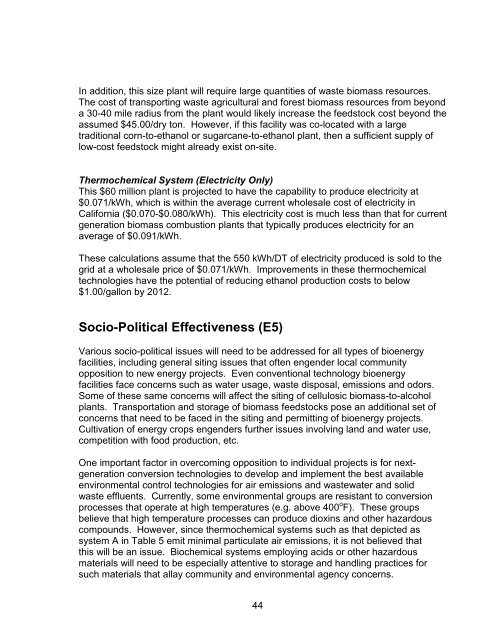Assessment of Conversion Technologies for Bioalcohol Fuel ...
Assessment of Conversion Technologies for Bioalcohol Fuel ...
Assessment of Conversion Technologies for Bioalcohol Fuel ...
You also want an ePaper? Increase the reach of your titles
YUMPU automatically turns print PDFs into web optimized ePapers that Google loves.
In addition, this size plant will require large quantities <strong>of</strong> waste biomass resources.<br />
The cost <strong>of</strong> transporting waste agricultural and <strong>for</strong>est biomass resources from beyond<br />
a 30-40 mile radius from the plant would likely increase the feedstock cost beyond the<br />
assumed $45.00/dry ton. However, if this facility was co-located with a large<br />
traditional corn-to-ethanol or sugarcane-to-ethanol plant, then a sufficient supply <strong>of</strong><br />
low-cost feedstock might already exist on-site.<br />
Thermochemical System (Electricity Only)<br />
This $60 million plant is projected to have the capability to produce electricity at<br />
$0.071/kWh, which is within the average current wholesale cost <strong>of</strong> electricity in<br />
Cali<strong>for</strong>nia ($0.070-$0.080/kWh). This electricity cost is much less than that <strong>for</strong> current<br />
generation biomass combustion plants that typically produces electricity <strong>for</strong> an<br />
average <strong>of</strong> $0.091/kWh.<br />
These calculations assume that the 550 kWh/DT <strong>of</strong> electricity produced is sold to the<br />
grid at a wholesale price <strong>of</strong> $0.071/kWh. Improvements in these thermochemical<br />
technologies have the potential <strong>of</strong> reducing ethanol production costs to below<br />
$1.00/gallon by 2012.<br />
Socio-Political Effectiveness (E5)<br />
Various socio-political issues will need to be addressed <strong>for</strong> all types <strong>of</strong> bioenergy<br />
facilities, including general siting issues that <strong>of</strong>ten engender local community<br />
opposition to new energy projects. Even conventional technology bioenergy<br />
facilities face concerns such as water usage, waste disposal, emissions and odors.<br />
Some <strong>of</strong> these same concerns will affect the siting <strong>of</strong> cellulosic biomass-to-alcohol<br />
plants. Transportation and storage <strong>of</strong> biomass feedstocks pose an additional set <strong>of</strong><br />
concerns that need to be faced in the siting and permitting <strong>of</strong> bioenergy projects.<br />
Cultivation <strong>of</strong> energy crops engenders further issues involving land and water use,<br />
competition with food production, etc.<br />
One important factor in overcoming opposition to individual projects is <strong>for</strong> nextgeneration<br />
conversion technologies to develop and implement the best available<br />
environmental control technologies <strong>for</strong> air emissions and wastewater and solid<br />
waste effluents. Currently, some environmental groups are resistant to conversion<br />
processes that operate at high temperatures (e.g. above 400 o F). These groups<br />
believe that high temperature processes can produce dioxins and other hazardous<br />
compounds. However, since thermochemical systems such as that depicted as<br />
system A in Table 5 emit minimal particulate air emissions, it is not believed that<br />
this will be an issue. Biochemical systems employing acids or other hazardous<br />
materials will need to be especially attentive to storage and handling practices <strong>for</strong><br />
such materials that allay community and environmental agency concerns.<br />
44
















